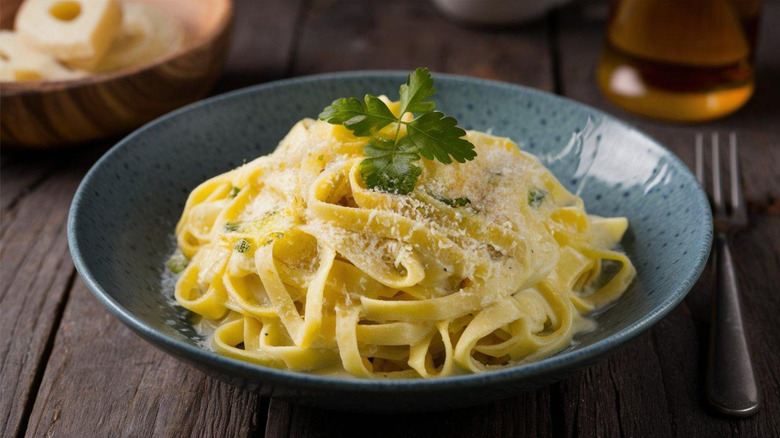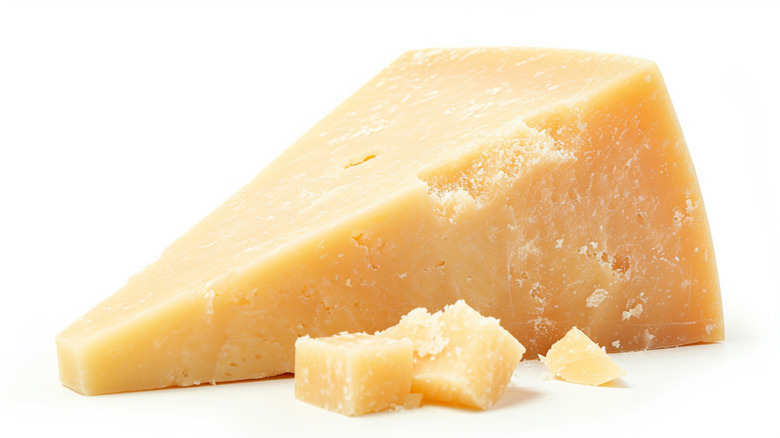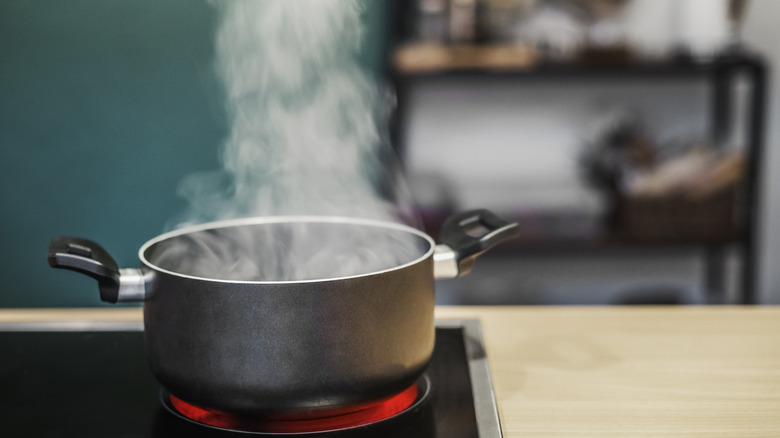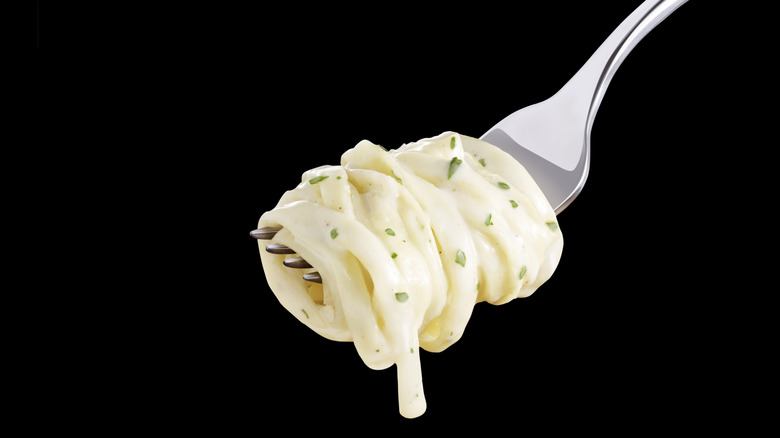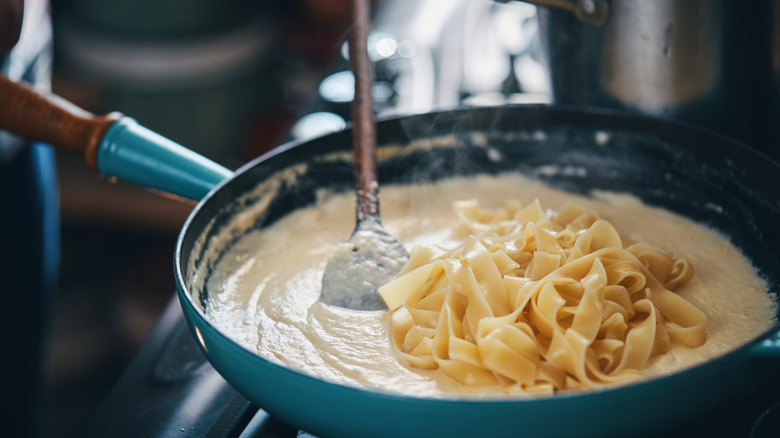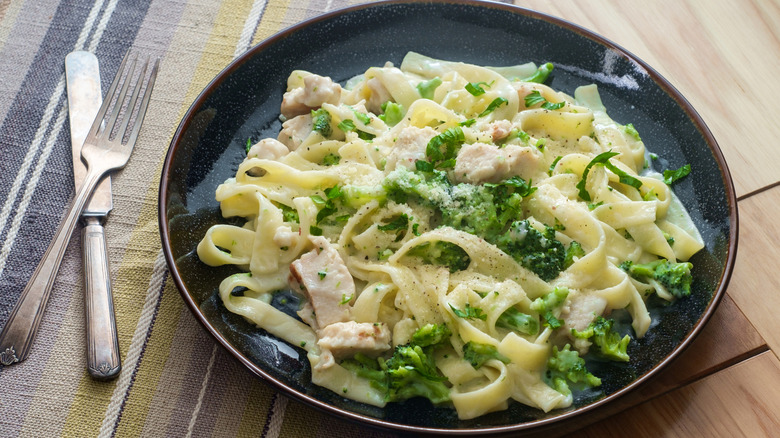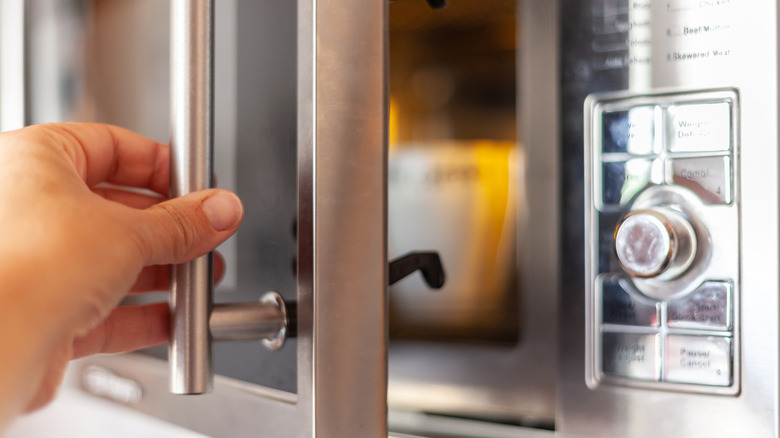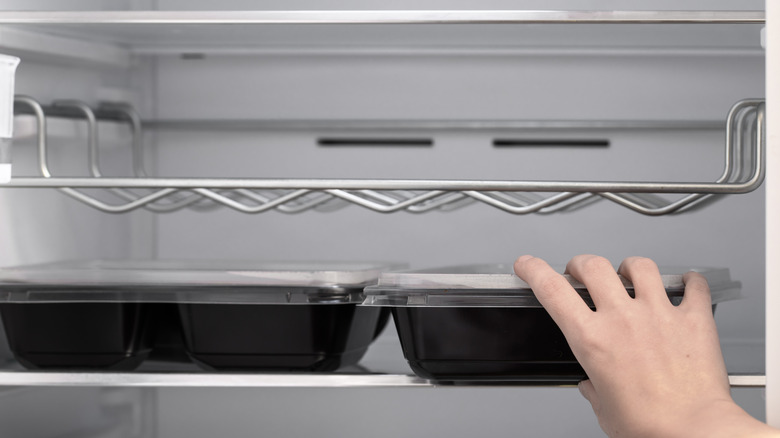10 Mistakes Everyone Makes With Fettuccine Alfredo
Fettuccine Alfredo is one of the most famous and well-liked Italian dishes across the United States. Starring fettuccine, a ribbon-like pasta, and a delicious white creamy and buttery sauce, this rich, satisfying dish is one of the most-ordered pasta dishes anywhere you can get your pasta fix. You may assume that fettuccine Alfredo was brought across the pond to us from Italy — and while you're not wrong, the dish itself has evolved over time from how Alfredo di Lelio himself created it. In the early 1900s, Alfredo started serving fettuccine pasta with copious amounts of butter, Parmigiano-Reggiano cheese, and some pasta water as a comfort meal that then turned into a staple at his restaurant. The "Americanized" version of fettuccine Alfredo we know and love today has a sauce of thicker consistency thanks to the addition of heavy cream and sometimes flour.
If you get a hankering for fettuccine Alfredo at home, you can grab a jar of store-bought sauce, toss it on your pasta, and voilà! You may find that those varieties don't live up to the hype. But if you really want to be guaranteed a delicious dish, making your own fettuccine Alfredo from scratch can yield insanely scrumptious results. There are some big mistakes you'll want to avoid in the cooking process, from creating the sauce to choosing your pasta type and even how you store it. Read on to find out how you can recreate your version of fettuccine Alfredo that impresses the pickiest of palates.
1. Choosing the wrong type of cheese
As with many pasta dishes, cheese is an imperative ingredient. If you have perused the cheesemonger section of your grocery store, you know there are many options to choose from. One thing that makes your fettuccine Alfredo fall flat is selecting the wrong cheese. Parmigiano-Reggiano is typically the traditional choice for fettuccine Alfredo. A younger Parmigiano-Reggiano (aged less than 18 months) is ideal for its delicate flavor, as those aged longer have more of a spicy kick.
To add to the cheese conundrum, Parmigiano-Reggiano and Parmesan are not necessarily the same in the U.S. Parmesan is a generic term that refers to cheese made similarly to Parmigiano-Reggiano — meaning you'll want to check the label closely to ensure you know what you are purchasing. The European Union has strict rules that allow them to be interchangeable. A second cheese choice is pecorino Romano cheese, which is sharper and saltier than Parmigiano-Reggiano to cut through some of the Alfredo sauce's richness for a balanced flavor. If you don't want to fully commit to either cheese, combine the two for the best of both worlds. Whether you choose Parmigiano-Reggiano, pecorino Romano, or experiment with another cheese like Grana Padano (an aged, hard Northern Italy cheese similar to Parmigiano-Reggiano), stick with the big blocks instead of the pre-grated packages. You may notice that the pre-grated versions may have a stronger, saltier taste and a different consistency than freshly grated cheese.
2. Subbing out fettuccine for the wrong pasta
It can be disappointing if you don't have the correct pasta for your fettuccine Alfredo in the pantry at home. The good news is that there isn't a hard and fast rule about what noodles you must use (although technically it wouldn't make sense for your dish to be called fettuccine Alfredo if the pasta isn't actually fettuccine). The fettuccine's long, flat shape inspired its name, which means "small ribbons" in Italian. Its texture and size make it the perfect accompaniment to the rich Alfredo sauce when twisted into nests.
However, if you don't have fettuccine, that doesn't mean you can't enjoy another type of pasta with your Alfredo sauce. Some possible substitutions are pappardelle, tagliatelle, or linguine. Pappardelle is even wider than fettuccine, while tagliatelle is used interchangeably with fettuccine despite its slightly narrower size. Linguini is the less ideal choice, as it is significantly thinner, so you will notice a difference in your dish. The one mistake you don't want to make with your pasta choice is selecting a smaller noodle that is too delicate for a heavier cream sauce like Alfredo. Smaller pasta shapes like orzo and elbow noodles are best used in soups, while finer pasta like angel hair or thin spaghetti holds up in lighter sauces. And while some of the twisting kinds of pasta like rotini can hold up to a heavy sauce, you may find it best utilized with a meat sauce.
3. Skipping heavy cream in your sauce
We have already tackled the issue of the original Roman-inspired fettuccine Alfredo and how it is actually different than the Americanized version that we all know and love. If you've made the decision to make fettuccine Alfredo with a creamy base, heavy cream is your best bet. Heavy cream has a higher fat content (even more than whipping cream), which gives the sauce the creamy and thick texture that perfectly coats your fettuccine.
You do have some substitution options if heavy cream isn't possible for you. Whipping cream can be a good substitute if you don't have heavy cream on hand. Half-and-half can be used in a pinch, but expect a thinner sauce that doesn't deliver on the texture front. You do want to avoid using milk, as it won't get your sauce to the thickness level you are likely used to. Some recipes may even use cream cheese to get that creaminess without heavy cream. This can be a workaround, but you may notice a slight difference in taste and texture from what you are used to in restaurants.
4. Overheating your Alfredo sauce
If you have ever made your own sauce, you know it is a process that requires patience. Trying to rush the simmer step for the sake of time can be detrimental to your sauce — especially with dairy-based sauces like Alfredo. Overheating your sauce by bringing it to a boil can cause your melted cheese to break up and separate within your sauce. This will leave unappetizing clumps throughout your sauce.
Instead, you want to slowly add your sauce ingredients at a low temperature. You can even go a step further and add your cheese in with the heat off to prevent overheating and clumping. However, letting that sauce hit boiling temperatures can happen to the best of us. If that's the case and you have an Alfredo sauce that has broken, there are some ways to try to salvage it. First, you should immediately remove your pan from the heat and cool it down by putting the pan in an ice bath or even adding an ice cube to your sauce directly. If you have a lot of clumps, you can make a roux or add some extra heated cream to the pan. You can also try to whisk out some clumps, but that may not be a fruitful effort if you have a huge amount. It should be noted that it is safe to eat a sauce that has curdled or broken, it just may not be as appealing with the typical smooth texture.
5. Overcooking your fettuccine noodles
There is nothing more disappointing than pasta that has been overcooked to a mushy texture. That is why you have probably heard of the term cooking pasta to "al dente," which translates to "to the tooth" in Italian. This means your pasta noodle still has a slightly firm resistance when you bite into it. Not overcooking your pasta is especially important in dishes like fettuccine Alfredo that require you to add your fettuccine into a hot sauce directly (more on that later), as your pasta will become softer from the residual heat.
Hitting that perfect al dente texture means you will want to remove the pasta from the boiling water while still firm, as pasta continues to cook slightly even when it has already been strained. That continued cooking process is called carryover cooking. If you are cooking store-bought dried fettuccine pasta, you will want to cook it for slightly less time than listed on the box to ensure you don't venture into overcooked territory. If you have opted to make your own fresh fettuccine, bravo to you! Fresh pasta takes even less time than its dried counterpart. Cook time can fall anywhere between two to five minutes, with flatter, thinner ribbon pasta like fettuccine leaning on the lesser time spectrum.
6. Not adding your noodles directly to the sauce
One of the best parts of a well-cooked pasta dish is when the sauce perfectly clings to the noodles. Some restaurants serve the long ribbon noodles perfectly twirled and gently tossed in the sauce arranged in an almost artistic manner. In fettuccine Alfredo's case, you don't want to just dump the sauce on at the last minute as an afterthought. This can cause the texture of the noodles and the sauce to be negatively impacted, with the sauce thickening up too much while the noodles stay watery.
You also lose out on that extra starch that releases from pasta and naturally thickens your sauce — a key step especially if your sauce appears on the thinner side. It may appear that you have a ton of Alfredo sauce at first, but that is likely not the case if you follow along with a recipe and stick to the measurements. You want to ensure your fettuccine (and any other accompaniments you decide to add) are coated evenly, hence the need for a lot of sauce. This step of adding noodles directly to the sauce correlates to the need for pasta to be cooked al dente and not overcooked.
7. Forgetting the protein
There is nothing wrong with the simplicity of fettuccine Alfredo on its own. However, you might be missing an opportunity to add some protein to your pasta to make it a full meal. The best part about making your own fettuccine Alfredo at home is you can tailor your dish to your personal protein preferences. Chopping up grilled chicken (or even using leftover rotisserie chicken) is a popular addition to Alfredo sauce due to its leanness and ability to complement bold flavors.
But, you can also amp up the flavor with some ground spicy Italian sausage. While you may think of ground beef in a chunky red sauce like bolognese, who's to say you can put it in Alfredo, too? Firing up the grill is also an option if you want to add your favorite steak cut — anything from filet to skirt steak can be a delicious addition. Pescatarians can opt for some grilled shrimp or even salmon if you are looking for a flavorful fish twist. Some even whisk in an egg yolk during the sauce-making to give a rich texture that inadvertently boosts the protein levels.
8. Not adding veggies to your Alfredo
We could all use some extra vegetables in our lives, right? Why not put them in a delicious Alfredo sauce with tasty fettuccine? Whatever vegetables you have on hand or in season can shine in a pasta dish like fettuccine Alfredo. Frozen peas can add a hint of sweetness and a pop of color, while baby spinach can cook right in when tossing the fettuccine in the sauce. Broccoli and cheese are a popular combination that would be right at home in a creamy Alfredo sauce. Sautéed broccolini or broccoli rabe are other green vegetable options popular in Italian cooking that packs a flavor punch.
If you are looking for some other hints of color, sliced red bell pepper can add some texture, while mushrooms shine in a butter sauce. Some chefs even use puréed cauliflower and whole milk instead of heavy cream to lighten up Alfredo sauce while also sneaking in some vegetables and making it vegan-friendly (if using a milk substitute). If nutritional content is your concern, you get some extra nutrients from the cauliflower and lower the cholesterol and fat content.
9. Reheating your dish improperly
The best part about making a dish like fettuccine Alfredo is enjoying the leftovers. However, you may end up disappointed if you don't reheat your dish properly. One tip to get that sauce tasting fresh again is to add moisture via milk or heavy cream when reheating to keep the noodles from drying out. The microwave can be your quick desperate reheat, but you may find that the sauce separates. Other methods yield a better taste and texture.
A double boiler is one of the more gentler methods via steam, but requires some technique, as you don't want the pasta to come into contact with the large pot of water. The oven can be a good way to reheat large amounts of pasta especially if already in a casserole pan, but it may take a while due to preheating time. You also want to be mindful of your fettuccine drying out in the oven, so keep an eye on it and add liquid if needed. An easy and quick method can be just throwing your fettuccine Alfredo back into a pan and cooking it on the stovetop with some garlic for added flavor.
10. Keeping your leftovers too long
We all want to enjoy the fruits of our cooking labor for as long as possible. However, you don't want to keep your leftover fettuccine Alfredo for too long for both freshness and food safety reasons. What you may not realize is that sauces that contain dairy like fettuccine Alfredo can spoil quicker than other sauces and can potentially lead to foodborne illnesses.
In order to keep your fettuccine as fresh as possible, you will want to first allow it to cool at room temperature before putting it in airtight containers. The containers are important to keep moisture in your dish and prevent any contaminants from entering. The timeframe your fettuccine will stay fresh decreases if you choose another method of storage instead, like wrapping your pasta in plastic (within three days) or putting it in the fridge uncovered (within two days).
You can store your leftovers in the main compartment of the fridge for a consistent temperature of 40 degrees Fahrenheit or lower. Using these storage tips should give you three to five days to enjoy your fettuccine Alfredo. Also be on the lookout for signs of spoilage like an odor, if your pasta becomes slimy or dry, dark spots or mold, or an off taste. Keeping a label with the date on your leftovers can help you track the days.
